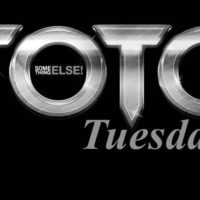Ask any Toto fan, and 1988’s The Seventh One is bound to rank high on their list of favorite albums.
Following a successful tour in support of 1986’s Fahrenheit, the songs on this follow-up release showcase the emerging chemistry between Joseph Williams and the group. In fact, it marks the first time since the departure of Bobby Kimball where the band has a vocalist in the chair long enough to make a second recording together. Adding two noted producers to the mix in George Massenburg and Bill Payne also brought a new dimension to the Toto sound, and they knew they were onto something.
Speaking in May 1988 – just after the release of The Seventh One – founding member and keyboardist David Paich told Keyboard magazine: “We’re really proud of the new record. I think it’s the best album we’ve made. Our cycle has been the first album, the fourth album, and this album – they all have a certain spirit about them.”
As if to leverage from the success of Toto IV, the album title references the numeric position in the catalog, while the Jeff Porcaro-designed cover artwork sees the prominent reappearance of the sword against a single color background.
This was to be their comeback. And so, to kick it off, “Pamela.” Considered by guitarist Steve Lukather to be the “heir apparent to ‘Rosanna’,” this David Paich and Joseph Williams-composed song introduces the listener to a more pristine sound and a tremendous live ambience compared to their previous releases.
Paich proudly states, “We played just about all of the basic tracks on The Seventh One live,” and this comes through: The music on this project breathes with rich dynamics and thoughtful interplay from these studio veterans. (Aside from the second track on The Seventh One: That’s a different story.)
During the verse of “Pamela,” the single-chord keyboard comp is a simpler approach than previous Toto songs. From the same Keyboard interview, Paich explains “We’re always trying to get simpler. My whole approach is to be able to write a one-chord song the way James Brown did.” You can sense he’s trying it out in the verse here.
This changes, however, in the pre-chorus, with a glorious hook. It’s such a rich harmonic progression by contrast, and is great to sing along with:
Don’t start mixing truth with jealousy
The road we’re on is clear as far as I can see.
The chorus and solos of “Pamela” are where it really happens though. Naturally, there are tight harmonies and a soaring tenor line from Joseph Williams – but listen closer. After the sing song of “Pamela,” there is a synth horn line, alternating with a vocal response, which is followed by a melodic guitar line.
The ear always has something fresh to latch onto. It’s quite cleverly conceived and expertly executed.
During the solos, you can tell this is a rejuvenated band. For the first time on a studio recording, we hear David Paich really cut loose with a cascading flurry of keys before Steve Lukather takes over with a searing lead, interspersed with a rapid fire finger-tapping break. These are clearly guys who can play and make it look effortless at the same time. With “Pamela,” Toto have brought the energy of their live performances into the studio.
“This track also boasts a great horn section of A-list session players (Chuck Findley, Gary Grant, Gary Herbig, Jerry Hey, James Pankow and Tom Scott), and a drum sound that is gripping. Often, I’ll listen to “Pamela,” and most of The Seventh One, just to focus on the drums: Jeff Porcaro plays with such force and a deft touch, giving his parts a conversational voice in the arrangements.
Now, if you’ve made it this far, there’s one more thing to mention and that’s the official video. We didn’t have MTV in Australia in the late ’80s, but I have watched this clip online and it is clear that the band was very image conscious at the time. Lavishly shot on a soundstage and including lots of cut-aways of models (along with the band members playing the horn section in silhouette), I’m guessing it would have been a significant investment from the record company.
Speaking of which, instability in the management at the record label meant the opportunity to capitalize on this resurgence was never realized. Although well received in Europe, The Seventh One wasn’t adequately promoted and didn’t chart well in the U.S. Further, “Pamela” only made it to No. 22 on the Billboard charts, becoming Toto’s sixth highest-peaking single and last charting to date.
Matters were further compounded by Joseph Williams losing his voice at the beginning of The Seventh One tour, and Toto’s lead singer problem rearing its head again.
I sometimes wonder what might have happened if this album received better label support and if Toto had persisted with Joe, but then I’m equally inclined to just grab my headphones and sit down with this album for some uninterrupted listening. Toto’s The Seventh One easily justifies its position near the top of my list.
- Toto, “Spanish Sea” from ‘Old Is New’ (2018): Toto Tuesdays - June 15, 2021
- Toto, “Devil’s Tower” from ‘Old Is New’ (2018): Toto Tuesdays - May 11, 2021
- Toto, “Alone” from ‘Old Is New’ (2018): Toto Tuesdays - April 27, 2021





The Seventh One is a gem. Given the Toto discography that is saying something. The band moved forward after the loss of Steve Porcaro and the moderate success with renewed energy and determination. To build on Fahrenheit’s momentum the band brought in Little Feats’ Billy Payne and their engineer, George Massenburg as co producers.
The lead off song Pamela, demonstrates the fruits of their labor. The David Paich, Joseph Williams composition is actually a melding of two songs each of he writers developed independently. The song grooves with a foundation of a tight Jeff Porcaro shuffle and Mike Porcaro’s aggressive 5 string bass playing. Williams really comes into his own as Toto’s vocalist leading the band through this upbeat love song with wild abandon. David Paich combines a rhythmic piano lead which is punctuated by Steve Porcaro synthesizer stabs and a Tom Scott arranged horn chart. Steve Lukather continues to work his guitar wizardry yet his solos do not sound as if he’s in any way repeating himself. Furthermore, Paich and Steve Porcaro square off in a keyboard solo section which is reminiscent of the section from Rosanna.
All the elements combine to make one of the most memorable Toto tracks to date. Unfortunately the song, like the album failed to catch on the with changing AOR audience , a sign of the long slow commercial fade of the band and the changing world of rock music. What a shame.
Great review! One of my favorite songs ever!